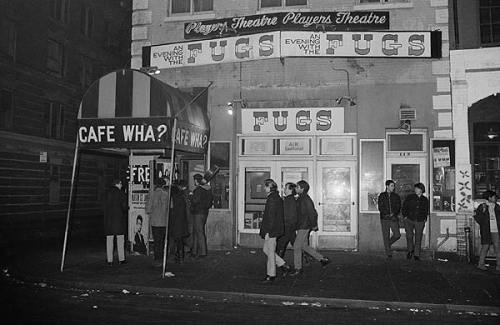Stop #4: MacDougal Street

Cafe Wha
On the other end of the block is the Minetta Tavern at 113 MacDougal Street, which was a primary New York hangout for Ernest Hemingway, Ezra Pound, Dylan Thomas, and others of the Lost Generation. Minetta Tavern and San Remo were prime spots for literary collaboration and community.
There are several other bars in this area that are important to the overlapping of the Beat culture and the up and coming Folk music scene in the 1960s. Places like Café Wha?, at 115 MacDougal Street, Gerde’s Folk City at 71 West 4th Street, and The Fat Black Pussycat, at 130 West 3rd St. This collaboration between the beats and the folk artists along MacDougal Street is described by Jens Lund and R. Serge Denisoff in their article, “The Folk Music Revival and the Counter Culture: Contributions and Contradictions” for The Journal of American Folklore Volume 84, Number 334, “In Greenwich Village, the beats and the folk-aficionados came into contact with each other, resulting in a synthesis of attitudes and appearances” (396). Lund and Denisoff imply that not only did these writers and musicians hang out in the same area but that they started to emulate each other.
This area was the centerpiece for the urban Folk movement led first by Joan Baez and then later by Bob Dylan. These folk artists worked to move folk music from the rural areas of the United States and to make them their own. Woody Guthrie and Pete Seeger were also vital to this process. Guthrie traveled with migrant workers from Oklahoma to California during the Dust Bowl and brought the songs he learned with him to the city.
Café Wha? was famous for being one of the first places that Bob Dylan performed when he came to New York City. It is said that he showed up at the place out of nowhere and asked the owner if he could perform. His first performance there consisted mostly of Woody Guthrie songs.
Gerde’s was one of the most popular Folk venues in the area and everybody who was anybody in Folk music was playing there in the early 1960s.
Also along MacDougal Street, The Folklore Center, at number 110, was a place of inspiration and creativity for many prominent artists of the folk scene. Izzy Young founded it in 1957. It was a central meeting place for folk artists, a place where they could experiment and collaborate.
Up Next: Washington Square Park




FTLGTP: “Monday Nothing…”
Stop #7: Cedar Tavern
Along the opposite side of the park from MacDougal runs University Place. Along University Place there was one bar in particular that was central for overlap of Beats and Folk artists. It was the Cedar Tavern, originally at 24 University Place. Cedar Tavern was also popular to the visual arts crowd during the time period. Regulars at Cedar Tavern included Jackson Pollock, Willem de Kooning, Mark Rothko, Allen Ginsberg, Jack Kerouac, members of The Fugs, and Bob Dylan.
One of the very first bands to mix folk and punk, The Fugs collaborated and borrowed much from the poets and other artists in the neighborhood including their name, which was borrowed from the pages of Norman Mailer’s The Naked and the Dead. Daniel Kane describes this connection in his essay, “From poetry to punk in the East Village” also for the Cambridge Companion:
This collaboration is something we see throughout Greenwich Village in both the literary and the musical movements and it seems to be vital to the kinds of artistic creativity that was produced.
(Here’s a glimpse into the music of The Fugs:)
Stop #8: Andy Warhol’s Electric Circus
Andy Warhol was particularly involved in the move to mix different kinds of art during this time period. He became the manager for the Velvet Underground and rented out the Polish National Social Hall, which he turned into the Electric Circus at 23 St. Mark’s Place, and used it as a performance space for the Exploding Plastic Inevitable, which included the Velvet Underground and poet Gerard Melanga.
1 Comment
Posted in Commentary, Cultural Events, Feature Stories, From the Lost Generation to the Punks
Tagged Allen Ginsberg, Andy Warhol, Baudelaire, Beat Generation, Berrigan, Bob Dylan, Cedar Tavern, Daniel Kane, Electric Circus, Exploding Plastic Inevitable, Folk, Gerard Melanga, Greenwich Village, Jack Kerouac, Jackson Pollock, MacDougal Street, Mark Rothko, New York City, Norman Mailer, Polish National Social Hall, Rimbaud, St. Mark's Place, The Fugs, The Naked and the Dead, University Place, Velvet Underground, Waldman, Washington Square Park, Willem de Kooning